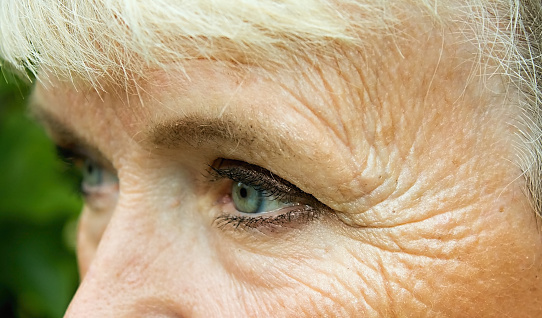 A report on recent pilot studies describes the development of a “second skin” composed of commonly used chemicals that can be “worn” over a person’s existing skin. While this innovative product has the potential to treat (but not cure) a variety of problematic skin conditions, the headline on the New York Times article on the subject reveals the hopes of the manufacturers: “‘Second Skin’ May Reduce Wrinkles, Eyebags, Scientists Say.” In the first paragraph the Times piece describes “an invisible film that can be painted on your skin and give it the elasticity of youth. Bags under the eyes vanish in seconds. Wrinkles disappear.”
A report on recent pilot studies describes the development of a “second skin” composed of commonly used chemicals that can be “worn” over a person’s existing skin. While this innovative product has the potential to treat (but not cure) a variety of problematic skin conditions, the headline on the New York Times article on the subject reveals the hopes of the manufacturers: “‘Second Skin’ May Reduce Wrinkles, Eyebags, Scientists Say.” In the first paragraph the Times piece describes “an invisible film that can be painted on your skin and give it the elasticity of youth. Bags under the eyes vanish in seconds. Wrinkles disappear.”
Far from being a product whose application is geared primarily to treat pathological skin conditions, the “second skin” promises new cosmetic uses that enhance the appearance of aging skin.
Cosmetics Use Controversy
An ongoing controversy in bioethics addresses the difference between medical interventions designed to cure or ameliorate diseases or conditions resulting from injuries or accidents, on the one hand, and interventions intended to “enhance” physical or mental functions and personal appearance on the other.
Perhaps the best-known example of this is the distinction between reconstructive facial surgery to restore a “normal” facial appearance following a disfiguring accident and cosmetic surgery such as a nose job or a face lift. However, the debate in the bioethics literature focuses on efforts to develop genetic enhancements that can make people smarter or give them superior physical abilities.
The widespread use (or abuse) of “performance enhancers” in competitive sports is a well-known example of a practice banned because of the unfair advantage it offers users. It is argued that cognitive enhancements are similarly unfair because they give students who would use them an advantage over their academic competitors.
But what about cosmetic enhancements for individuals in a noncompetitive setting: those of us with wrinkled skin due to aging? Is there anything ethically wrong with scientists and industry developing physical enhancements that disguise some of the inevitable signs of aging?
Important Cover-Ups
To be fair, the “second skin” does have important medical applications. As the article notes, it can be used “to treat eczema, psoriasis and other skin conditions by covering dry itchy patches with a film that moistens and soothes.” The abstract of an article published in Nature Materials by the scientists who conducted the pilot studies mentions that the product “may offer advanced solutions to compromised skin barrier function, pharmaceutical delivery and wound dressings.” These uses certainly provide medical benefits to patients. However, the abstract actually begins with a sentence that describes this polymer layer as something “that mimics the properties of normal, youthful skin.” Clearly, the authors had in mind cosmetic as well as therapeutic uses. A Harvard dermatology professor and member of the research team said that one of the first applications was on undereye bags. The Times article describes this affliction as “a condition that plagues so many middle-aged and older people.” Few things better illustrate the obsession with youth in our culture. “Plagues,” indeed.
The Priorities Question
Let me hasten to say that I see nothing ethically problematic with people choosing to use cosmetic enhancements, be they surgical or chemical. Furthermore, a product such as the “second skin” does have medical applications that can provide relief for people who suffer from painful, disfiguring or uncomfortable skin conditions. However, it is the cosmetic applications that are most likely to make money for the privately owned biotechnology company that funded the research and the privately owned company that holds the patents. The Times article notes that all of the authors of the paper published in Nature Materials have equity interests in both of these commercial companies.
If there is an ethical problem with developments such as this and other enhancements, it lies primarily with setting priorities in biomedical research. It is true that private companies can conduct research on whatever they wish as long as they do not violate laws or regulations. And, as long as taxpayers’ money is not used, say, for National Institutes of Health research on such pursuits, private money devoted to reducing wrinkles is simply business as usual.
But, in a world where emerging infectious diseases are causing global concerns and where chronic diseases such as diabetes and cancer are increasingly prevalent in resource-poor countries, devoting resources to eliminate bags under the eyes of middle-aged and elderly residents of resource-rich countries raises profound questions of justice.
The newspaper article quoted a Harvard faculty member who tried the product under his eyes: “It does work…. But it was a little depressing…. I didn’t realize I had those bags.” After reading the article I looked in the mirror. What I discovered was age-appropriate bags under my eyes. Since I’m not planning to enter a geriatric beauty contest, I’ll save my own limited resources for other pursuits.


Comments on this entry are closed.
Well stated. Thank you, Dr. Macklin.